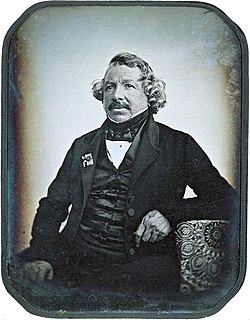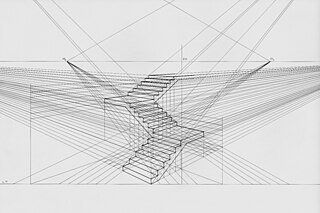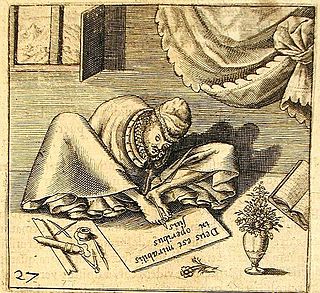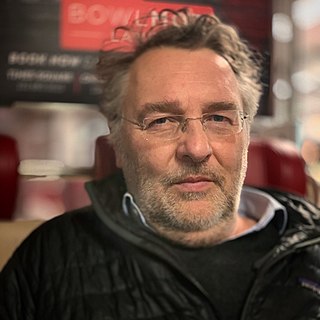Related Research Articles

Photography is the art, application, and practice of creating durable images by recording light, either electronically by means of an image sensor, or chemically by means of a light-sensitive material such as photographic film. It is employed in many fields of science, manufacturing, and business, as well as its more direct uses for art, film and video production, recreational purposes, hobby, and mass communication.

A camera obscura is a darkened room with a small hole or lens at one side through which an image is projected onto a wall or table opposite the hole.

Daguerreotype was the first publicly available photographic process; it was widely used during the 1840s and 1850s. "Daguerreotype" also refers to an image created through this process.

David Hockney is an English painter, draftsman, printmaker, stage designer, and photographer. As an important contributor to the pop art movement of the 1960s, he is considered one of the most influential British artists of the 20th century.

A camera lucida is an optical device used as a drawing aid by artists and microscopists.

Linear or point-projection perspective is one of two types of graphical projection perspective in the graphic arts; the other is parallel projection. Linear perspective is an approximate representation, generally on a flat surface, of an image as it is seen by the eye. Perspective drawing is useful for representing a three-dimensional scene in a two-dimensional medium, like paper.

Irises is one of several paintings of irises by the Dutch artist Vincent van Gogh, and one of a series of paintings he made at the Saint Paul-de-Mausole asylum in Saint-Rémy-de-Provence, France, in the last year before his death in 1890.
William Eggleston is an American photographer. He is widely credited with increasing recognition for color photography as a legitimate artistic medium. Eggleston's books include William Eggleston's Guide (1976) and The Democratic Forest (1989).

Rodney Graham is an artist and musician born in Abbotsford, British Columbia. He is most often associated with the Vancouver School.

The history of photography began in remote antiquity with the discovery of two critical principles: camera obscura image projection and the observation that some substances are visibly altered by exposure to light. There are no artifacts or descriptions that indicate any attempt to capture images with light sensitive materials prior to the 18th century.

The Getty Center, in Los Angeles, California, is a campus of the Getty Museum and other programs of the Getty Trust. The $1.3 billion center opened to the public on December 16, 1997 and is well known for its architecture, gardens, and views overlooking Los Angeles. The center sits atop a hill connected to a visitors' parking garage at the bottom of the hill by a three-car, cable-pulled hovertrain people mover.

William Franklin McMahon was an American artist-reporter. of The Sunday Telegraph of London:
Nina Sobell is a contemporary sculptor, videographer, and performance artist. She began creating web-based artworks in the early 1990s.
Tauba Auerbach is a visual artist working in many disciplines including painting, artists' books, sculpture and weaving. They live and work in New York.
Merlin James is an artist living and working in Glasgow, Scotland.

Mouth and foot painting is a technique to create drawings, paintings and other works of art by maneuvering brushes and other tools with the mouth or foot. The technique is mostly used by artists who through illness, accident or congenital disability have no use of their hands. The Association of Mouth and Foot Painting Artists (AMFPA) is a worldwide organization representing these artists.

Anna Walinska was an American painter. She is known for her colorful works of the Modernist period, collages done with handmade Burmese Shan paper, and a large body of works in various media on the theme of the Holocaust. Works by Walinska are included in numerous public collections, most notably the National Portrait Gallery, the National Museum of Women in the Arts, the Smithsonian American Art Museum, the United States Holocaust Memorial Museum, the Rose Art Museum at Brandeis University, the Denver Art Museum, The Jewish Museum in New York, the Herbert F. Johnson Museum of Art at Cornell, the Zimmerli Art Museum at Rutgers University, the Judah L. Magnes Museum in Berkeley, and Yad Vashem. Walinska's scrapbooks of the Guild Art Gallery, along with sketchbooks and journals on world travel are included in the Archives of American Art at the Smithsonian Institution.

Richard Learoyd is a British contemporary artist and photographer.

Nyeema Morgan is an American interdisciplinary and conceptual artist. Working in drawing, sculpture and print media, her works focus on how meaning is constructed and communicated given complex socio-political systems. Born in Philadelphia, she earned her BFA from the Cooper Union School of Art and her MFA from the California College of the Arts. She has held artist residencies at the Skowhegan School of Painting and Sculpture and Smack Mellon. Morgan's works are in the permanent collections of the Bowdoin College Museum of Art and the Menil Collection.
References
- ↑ "Ryan and Trevor Oakes Biography, Wiki, Net Worth, Age, Family, Twitter, Instagram, Facebook". www.wikiinformer.com. Retrieved 10 February 2022.
- ↑ "Union List of Artists Names". www.getty.edu. Retrieved 9 March 2015.
- ↑ Weschler, Lawrence (August 15, 2014). "How a Pair of Twins Redrew an Iconic Photograph With Camera-Like Precision". New York Times.
- ↑ Frank, Priscilla (May 29, 2014). "Identical Twins Combine Art And Math In Hypnotic Exhibition". Huffington Post. Retrieved 9 March 2015.
- 1 2 Weschler, Lawrence. "Double Vision: The Art of Trevor and Ryan Oakes". VQR: A National Journal of Literature and Discussion (Spring 2009).
- ↑ Alexandria, Sivak. "Double Draw: The Oakes Brothers at the Getty". www.getty.edu/iris. Retrieved 9 March 2015.
- ↑ Stephan, Annelisa. "Watch the Oakes Brothers' Drawing of the Getty Take Shape, Line by Line". www.getty.edu/iris. Retrieved 9 March 2015.
- ↑ James, Damien (October 23, 2008). "The Magic Easel Twin artists Trevor and Ryan Oakes have invented a new way to draw". Chicago Reader. Retrieved 9 March 2015.
- ↑ Hoffman, Jascha (April 28, 2014). "Science Events: Unusual Vision and D.I.Y. Neuroscience". New York Times.